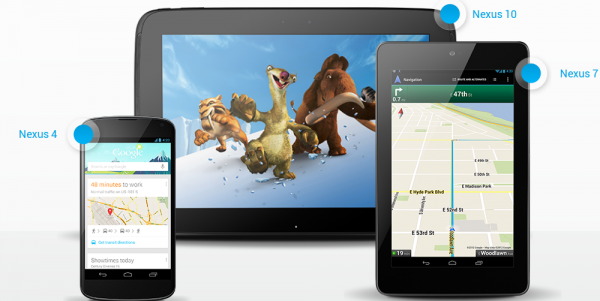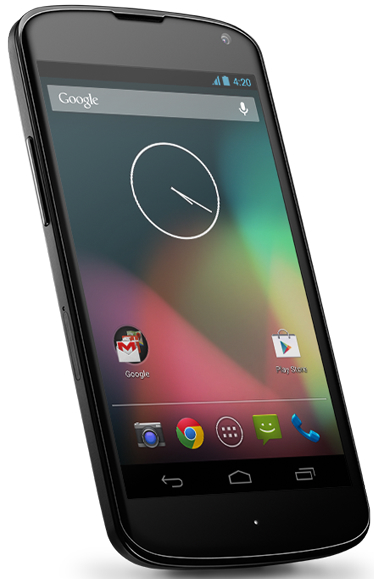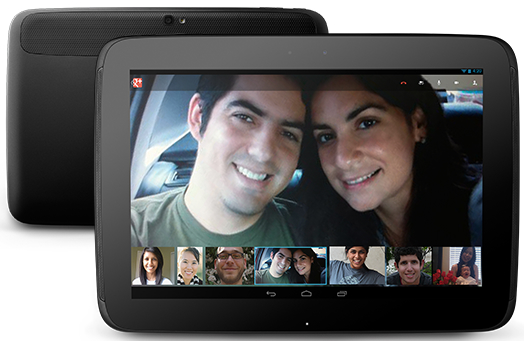Google Nexus 10 is ugly, and Nexus 4 has no LTE

Damn, and I had so expected to upgrade.
Surely there's a metaphor here somewhere. Hurricane Sandy blew out Google's Android event, but the news came anyway like a storm raining down on Windows Phone 8's launch. Today, Google debuted the long-rumored Nexus 4 smartphone and Nexus 10 tablet, added a 3G Nexus 7 to the product family and took the wraps off Android 4.2. But in looking over the news, I'm not nearly excited as I expected to be. The new handset is HSPA+, in a LTE world. The larger tablet lacks the design charm that makes Nexus 7 so appealing; Samsung produces what in the photos looks like a stuffed Galaxy Tab with super duper high-resolution display. Maybe I'll warm up before sales start November 13. How unlucky a number is that?
We have three stories up on the news, but not a one goes through the system configurations. So I'll give them up here, as well as pricing. Google Play will carry all the devices, and T-Mobile will offer Nexus 4 and 3G Nexus 7 -- the latter for as yet unspecified subsidized price.
Since Google is using a three-size marketing tagline, I'll follow that and discuss the devices from smallest to largest.
Nexus 4
LG produces the smartphone. Samsung makes predecessor Galaxy Nexus, which I use.
Specs. 4.7-inch IPS display, 1280 x 768 pixel resolution, 320 pixels per inch; Qualcomm Snapdragon S4 Pro processor; 2GB RAM; 8GB or 16GB storage (depending on model); 8-megapixel rear-facing and 1.3MP front-facing cameras; GSM/EDGE/GPRS (850, 900, 1800, 1900 MHz), 3G (850, 900, 1700, 1900, 2100 MHz), HSPA+ 21; WiFi N; wireless charging; Bluetooth; NFC; SlimPort HDMI; accelerometer; ambient-light sensor; barometer; compass; GPS; Gyroscope; microphone; 2,100 mAh battery; unlocked; Android 4.2. Measures 133.9 x 68.7 x 9.1 mm and weighs 139 grams.
The 8GB model sells for $299 and the larger-capacity one for $349, starting November 13. T-Mobile's subsidized price is $199, available a day later.
The good.
- Phone is unlocked and carrier contract free.
- Entry-level price is now $50 less and quite a value.
- Packs 2GB RAM, which is twice that of earlier Nexus smartphones.
- The main camera is 8MP and supports new features found in Android 4.2.
- T-Mobile remains in Google's good graces, with its odd data frequencies supported. Actually, every Nexus device, and even the first Google phone (G1), runs on T-Mobile's data network.
 The bad.
The bad.
- There's no LTE, which is simply unacceptable for a smartphone in this price range.
- Samsung displays are remarkable for brightness and contrast, but Nexus 4 is LG-manufactured.
- Many buyers will suffer sticker shock, not necessarily seeing the hidden, contractual price difference between a subsidized $199 phone with 16GB storage for $199 compared to Nexus' 8GB for $299.
I am hugely satisfied by Galaxy Nexus, which camera is remarkably good. I lack confidence that LG will deliver as good, even with 8MP (GN has 5MP). Then there is no LTE, which is just about a deal breaker for me. Faster bandwidth is the biggest benefit I can see upgrading to any new handset. Carrier subsidized LTE, like the models available from Sprint or Verizon, isn't acceptable. So-called "pure Google" should be better, and HSPA+ isn't good enough for me. Of course, in part that's because I'm on AT&T. T-Mobile offers superior HSPA+ in my experience. You?
Nexus 7
Google's 7-inch tablet, which ASUS produces, is largely unchanged. The 8GB model is gone, replaced by the 16 gigger for the same $199 price. Stepping into $249 is Nexus 7 32GB, which is new. Google also offers a 32GB 3G tablet for $299.
Specs. 7-inch back-lit IPS display, 1280 x 800 resolution, 216 ppi; 1.3GHz Nvidia Tegra 3 quad-core processor; 1GB RAM; 16GB or 32GB storage (depending on model); 1.2-megapixel front-facing camera; GSM/EDGE/GPRS (850, 900, 1800, 1900 MHz), 3G (850, 900, 1700, 1900, 2100 MHz), HSPA+ 21 (one model); WiFi N; Bluetooth; accelerometer; GPS; gyroscope; magnetometer; microphone; NFC; 4325 mAh battery; unlocked; Android 4.2. Measures 198.5 x 120 x 10.45mm and weighs 340 grams.
T-Mobile's price is a mystery, but subsidized could get the price down to $149 or even $99 under two-year contract.
The good.
- Exceptional value for microprocessor and storage capacity.
- Quad-core processor simply isn't otherwise available in this price range.
- Once again, Google sticks with T-Mobile by supporting its HSPA+ frequencies.
- Apple's cheapest iPad mini costs $30 more, with half the storage, less screen resolution and no cellular option.
The bad.
- There's no LTE, which puts cellular capability behind all other mainstream tablets.
I'm tempted by the 3G model. I had considered moving up to the 32GB model, as the 8 gigger is no longer enough. For $50 more, there's cellular radio and my family is on AT&T's shared data plan. I currently use the now retired tablet more than any other computing device.
Nexus 10
Samsung makes the long-rumored tablet, which, for my tastes, bears too much resemblance to Galaxy Tab 2 10.1 -- right down to the front-facing speakers. No wait! It's more like a cross between Tab and Motorola XOOM, what their offspring might be.

Specs. 10.055-inch display, 2560 x 1600 resolution, 300 ppi; 1.7GHz Exynos 5 (Cortex A-15) dual-core processor; Mali T604 graphics chip; 2GB of RAM; 16GB or 32GB storage (depending on model); 5MP back- and 1.9MP front-facing cameras; WiFi N; micro HDMI; Bluetooth; accelerometer; ambient-light sensor; barometer; compass; GPS; gyroscope; microphone; NFC; 9000 mAH battery; Android 4.2. Measures 263.9 x 177.6 x 8.9 mm and weighs 630 grams.
The good.
- Thinner and lighter than iPad 4.
- 2GB RAM is twice that of most other tablets.
- Highest screen resolution of any tablet, even iPad 4.
- Tighter pixel density of any other tablet (iPad 4 is 264).
- Dual-core processor and graphics chip are superior performers.
- Price is aggressive compared to iPad 4; 16GB sells for $100 less.
- Front-facing speakers are better positioned for digital entertainment.
The bad.
- Overly-rounded corners won't appeal to some people (like me).
- Overall industrial design suggests chubbiness where there really isn't any.
- Front-facing speakers could cause feedback during video calls or Google+ Hangouts.
- There is no 64GB model, which is unfortunate given the marketing push around magazines and other digital content.
Google sells the 16GB Nexus 10 for $399 and the 32GB one for $499.
I have mixed feelings about the tablet, and wonder about you. The screen resolution is huge benefit almost to a fault. Will anyone want to use a PC or other tablet after experiencing such visual crispness?
But I'll concede this: Nexus 10 sets the standard for all Android tablets and quite possibly for any other, including iPad 4 and Surface RT. My gripes about design aside, Google and Samsung deliver a device specked to the max.